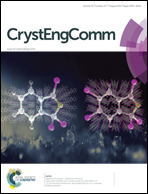Crystallization of Fe3+ in an alkaline aqueous pseudocapacitor system†
Abstract
For the first time, we have studied the crystallization behavior of FeCl3 in an aqueous alkaline pseudocapacitor system, where FeCl3 can be effectively transformed into Fe2O3·H2O colloids by an in situ crystallization process in KOH electrolyte under an electric field. In alkaline aqueous solution, the Fe3+ cations firstly react with OH− and crystallize into goethite Fe2O3·H2O colloids. During the electrochemical tests, the crystallization of Fe3+ was interrupted by an external electric field due to a Faradaic redox reaction, resulting in fine and highly electroactive Fe2O3·H2O colloids. For the currently designed FeCl3 pseudocapacitor system, a very high capacitance of 977 F g−1 at the current density of 3 A g−1 and a high energy density of 23.6 Wh kg−1 at the power density of 3400 W kg−1 can be obtained. Rate performance tests show that 86% of the capacitance can be maintained after the galvanostatic current density increases from 3 to 15 A g−1. Our current pseudocapacitor system can provide a versatile method for the construction of high-performance inorganic pseudocapacitors by in situ crystallization via chemical/electrochemical reactions in room temperature aqueous solution.


 Please wait while we load your content...
Please wait while we load your content...